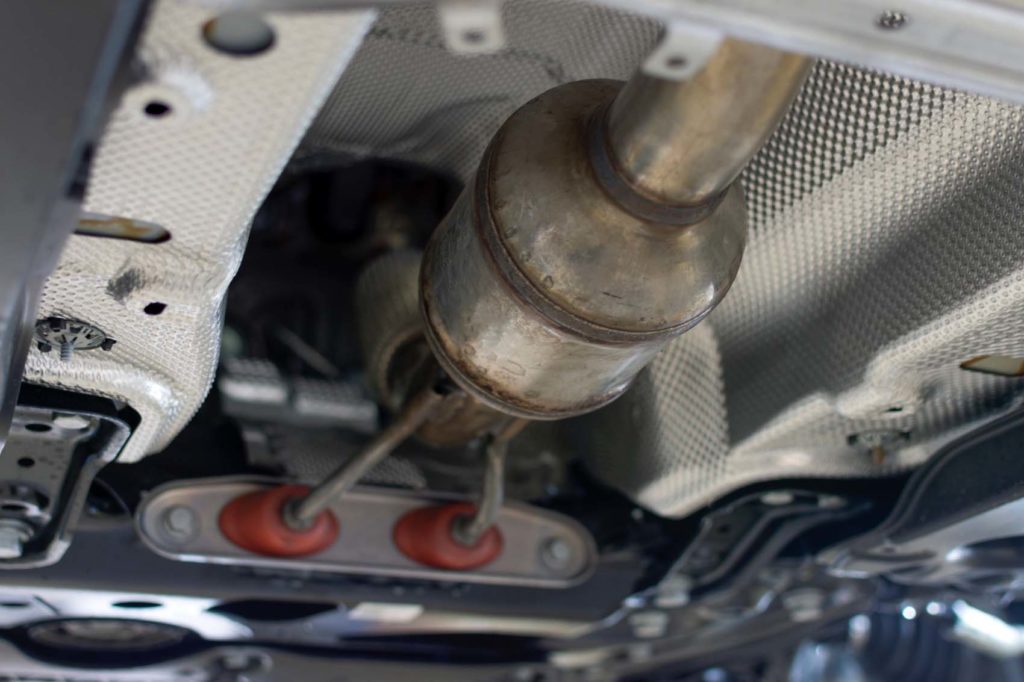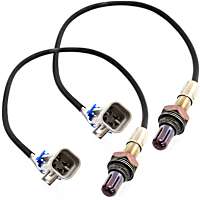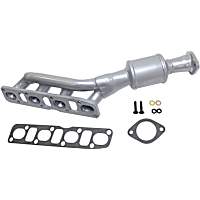What Does the P0421 Code Mean?
Code P0421 indicates a problem with the warm-up catalytic converter (also known as the “Light Off Cat”). That’s the catalyst nearest the engine. There is another catalyst behind this catalyst – that’s not the one this code refers to. That rear catalyst isn’t monitored. This one is.
Note that a P0421 code is not listed on most vehicles. The most common vehicle that will store this code are Mazdas and some Mitsubishi vehicles.

For example, this is how a Mazda decides whether or not to store a P0421:
- The PCM monitors the catalytic converter’s oxygen storage capacity.
- The PCM temporarily changes the target air/fuel ratio to rich at “fuel cut” recovery, and detects the response time until the HO2S output signal outputs the voltage on the rich side.
- If the catalytic converter purification characteristic deteriorates, the amount of the time until the HO2S detects the voltage on the rich side is shorter compared to the normal purification characteristic.
- The PCM detects a catalytic converter malfunction using this performance characteristic.
Although the trouble code P0421 is related to your vehicle’s catalytic converter, it does not always mean that the converter is faulty. It could also indicate other issues, such as a circuit problem or a bad oxygen sensor.
The main function of the oxygen sensor is to monitor your vehicle’s exhaust output and send the data to your vehicle’s powertrain control module (PCM). The PCM then compares the data from the upstream and downstream oxygen sensors to determine catalyst efficiency.
If you want to learn more about catalysts, the role they perform in a vehicle’s emission control system, and how OBD2 codes can be triggered by this system, read our technical explanation here.
To learn the possible causes of P0421, read the next section.
P0421 on Some Mazda Vehicles
The P0421 code appears in a 2010 Mazda 6 2.5L because of the following conditions:
- Leakage exhaust system
- Loose A/F sensor
- Loose HO2S
- TWC deterioration or malfunction
- PCM malfunction
What are the Possible Causes of the P0421 Code?
Here are some of the common triggers of the error code P0421:
- Faulty Bank 1 catalytic converter
- Faulty oxygen sensor
- Issues with the oxygen sensor circuit, such as damaged wires or poor connections
- Exhaust leak
- An issue with the PCM, such as software in need of an update

What are the Common Symptoms of the P0421 Code?
Although P0421 is a generic code, its symptoms may vary depending on your car’s year, make, and model. For example, the symptoms of the code P0421 for Mitsubishi vehicles may differ from error code P0421 for Mazda cars. Here are some of the most common symptoms related to the P0421 code:
- Illuminated Check Engine Light
This is the most common warning sign of the P0421 code. As a general rule, it is recommended to have your vehicle checked by a mechanic once the check engine light illuminates, regardless of the trigger.
- Lack of engine power
In some cases, the catalytic converter may become clogged, creating excessive exhaust back pressure. This can result in a lack of engine power.
How to Diagnose the P0421 Code
Since P0421 is a generic code, it can be seen in various makes and models. However, keep in mind that the diagnostic and repair steps may vary depending on your vehicle’s make and model. Here is a video to help you understand what the troubleshooting process might involve:
How to Fix the P0421 Code
Disclaimer: Due to the wide variability in vehicle makes and models, as well as other factors, the following information must not be construed as complete or the only definitive way to address a particular issue. Instead, the following content merely attempts to give you a better idea of what a do-it-yourself approach to the issue might involve. You are encouraged to find more technical resources regarding the subject or take your vehicle to a professional technician for the best results.
Fixing the P0421 code can be difficult especially if you don’t have the tools and technical know-how to get the job done. But if you’re a seasoned DIYer who’s up for the challenge, here’s a step-by-step guide that you can read. This will give you an idea about how to go about the repair process.
Take note, however, that this is only a guide. We also recommend consulting vehicle-specific repair manuals like Chilton for the exact step that’ll work for your vehicle.
Verifying the Issue
Before proceeding with the repair, you’ll have to verify what’s causing the problem. Here are some of the usual things that mechanics do when a P0421 code is retrieved:
Step 1: Physically Inspect the Exhaust System
You’ll have to inspect your exhaust system for any signs of leak. Look for an accumulation of soot in the exhaust pipe.
Step 2: Check the Condition of your Catalytic Converter
To verify that your cat-con is the issue, you can do a smell test. If you smell a sulfur-like odor, then your catalytic converter is probably the issue.
You can also test the converter while your engine is running. Once your cat-con turns red and you hear rattling, you’ll need to replace the converter.
Step 3: Inspect the Wiring and Connectors
You’ll also need to inspect the wiring and connectors of your oxygen and A/F sensors for any signs of fraying or disconnection. This will help you rule out any underlying issues causing similar symptoms.
Step 4: Check the Freeze Frame Data
A mechanic will also retrieve the freeze frame data to get a clearer picture of the issue.
Freeze frame data refers to the snapshot of the sensor and component readings during the time the malfunction was detected.
They may also do a drive test to compare the symptoms.
Step 5: Check Sensor Voltage Readings
You can also check the voltages of your Bank 1 O2 and A/F sensors, so that you can compare them with the specifications set by your manufacturer. The Bank 1 Catalytic Converter has failed and needs to be replaced if the Post-Catalyst O2 sensor exhibits a rapidly varying voltage between 0.1V and 1V.
Replacing the Catalytic Converter
The tools needed to replace a catalytic converter can vary depending on the type of vehicle that you own. You’ll usually have to have the following tools with you:
- Anti-seize
- Jack and jack stands
- Oxygen sensor wrench or socket (optional)
- Penetrating oil
- Pry bar and/or dead-blow hammer
- Ratchet, appropriate size sockets and wrenches
- Safety glasses or protective goggles
- Scan tool or code reader (optional)
- Torque wrench
It’s important to note that the process of replacing a cat-con can also vary depending on where it’s installed on your vehicle. For instance, some catalytic converters can be integrated into the exhaust manifold while others are bolted between the exhaust manifold and exhaust pipe (or muffler).
You can take a look at our guide on how to replace bolt-in converters here.
What to Do After Cat-Con Replacement
After replacing the faulty catalytic converter, you’ll have to use the scan tool to clear the trouble code. If you don’t do that, the check engine light can continue to appear until the control module runs a self-test again.
A Lesson on Catalysts and How they Can Trigger OBD2 Codes
The catalytic converter is mounted in the exhaust system and basically looks like a muffler. All the exhaust passes through the catalytic converter, and engines with two banks will have more than one converter. When working properly, the converter chemically transforms pollutants created by the engine into harmless water vapor and carbon dioxide.

The three enemy gasses the emissions system targets are
- NOx (Oxides of Nitrogen)
- HC (Hydrocarbons, or unburned fuel)
- CO (Carbon Monoxide, which is invisible, odorless, and deadly poison in a closed space).
A “catalyst” changes other things it comes in contact with without undergoing change itself. Today’s vehicles have what is known as a three-way catalyst that handles all three of the harmful gasses.
A “catalyst” changes other things it comes in contact with without undergoing change itself. Today’s vehicles have what is known as a three-way catalyst that handles all three of the harmful gasses.
–Richard McCuistian, ASE Certified Master Automobile Technician
The catalytic converter has a hard clay “honeycomb” coated throughout with very fine particles of precious metals like platinum, palladium, rhodium, etc. Those precious metals are the chemical element of the catalytic converter, which must get very hot (over 1,000 degrees) before it begins to do its work. That’s why the “light off” (warm up) catalyst is mounted so near the engine.
As for the P0421 code, it’s important to note that it only points to a problem with the warm up converter that is mounted closest to the engine. That’s also true of the P0420 and P0430 codes. As stated earlier, the rear converter isn’t monitored by the OBD 2 system. Some converters have both “bricks” in one shell with the warm up cat’s special monitoring O2 sensor screwed right into the middle of the converter between the two bricks.
Catalysts and Emissions
The warm up converter nearest the engine handles NOx emissions (a product of high combustion temperatures) and the catalyst farthest from the engine handles HC and CO (from too-rich mixtures). A healthy engine with a healthy catalyst system will produce CO2 and water vapor at the exhaust, both of which are actually beneficial to plants and the planet. As you’re breathing right now, you’re producing water vapor and CO2 just like a healthy vehicle.
Remember, normal combustion creates water vapor – that’s why all that steam comes from the exhaust until the exhaust system warms up when you start a vehicle in cold weather. An engine typically produces a gallon of water for every gallon of fuel consumed. Is this a problem? Not at all. Neither is CO2. The grass and trees love CO2; as a matter of fact, they can’t survive without it, and as they consume it, they give off oxygen – which we need just as badly as they need CO2. That plant-feeding CO2 is one of the reasons they have to mow the roadsides so much.
Since 1996, OBD2 (On Board Diagnostics 2) regulations have required the PCM (that’s the vehicle’s engine computer) to keep track of the catalytic converter’s performance by monitoring the downstream oxygen sensor; that’s the one behind the warm up catalytic converter.
If you’re advanced enough to watch live data on a scan tool or with your smartphone app talking to a dongle connected to the DLC connector on a healthy engine, you’ll see the upstream O2 sensor the computer uses to balance the air/fuel mixture switching rapidly (several times per second) and you’ll see the downstream corresponding O2 sensor switching much slower.
That’s the way it’s supposed to be, you see. When the downstream sensor begins to switch at the same rate as the upstream sensor, the P0420/P0430 codes are stored by the PCM to flag the failure of the catalyst to store oxygen, which is something it’s supposed to do.
How to Get a New Catalytic Converter
If your vehicle has a damaged catalytic converter, stop driving it. While your engine can still run with a damaged catalytic converter, you’re likely to experience a drop in performance and fuel economy. In some cases, your engine might even fail to start. For your own sake, it’s best to avoid driving until you can replace your catalytic converter. Thankfully, getting a new catalytic converter is fast and easy with CarParts.com.
As a one-stop shop for OE-grade parts, CarParts.com offers the best catalytic converters in the market. Enjoy a hassle-free shopping experience thanks to our accurate and detailed fitment information. We remove the guesswork, so you can get the catalytic converter that perfectly fits your vehicle. If you need any help with your order, don’t hesitate to reach out to our customer support team who will be more than happy to assist you.
Don’t wait until your catalytic converter completely breaks before replacing it. Check out our selection of high-quality catalytic converters at CarParts.com and order today!
Products Mentioned in this Guide
Any information provided on this Website is for informational purposes only and is not intended to replace consultation with a professional mechanic. The accuracy and timeliness of the information may change from the time of publication.


 Oxygen Sensor
Oxygen Sensor
 Catalytic Converter
Catalytic Converter
















